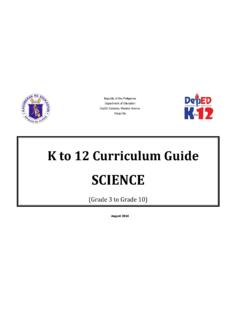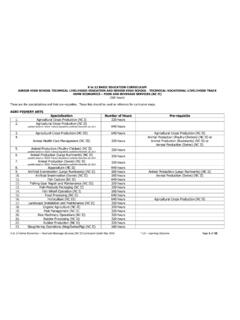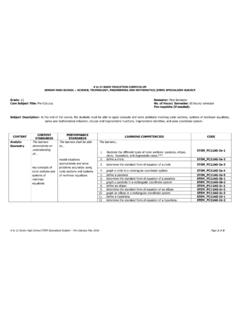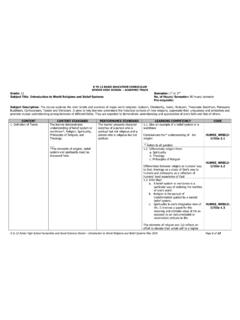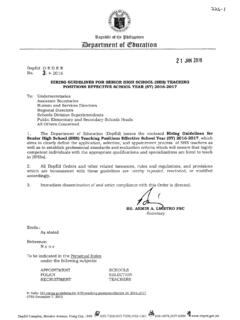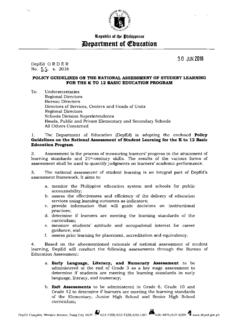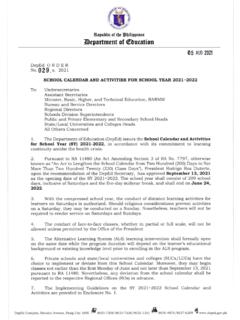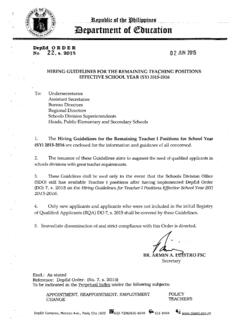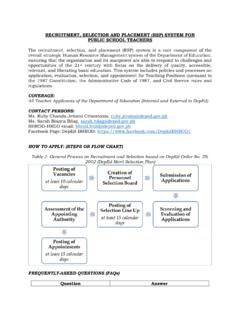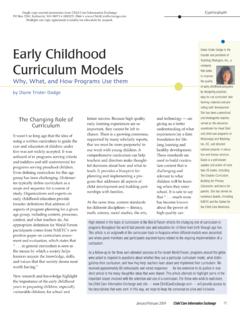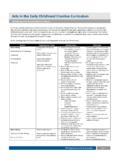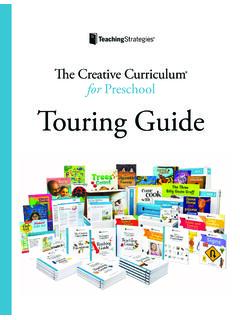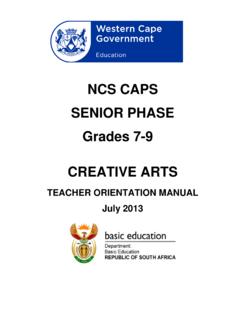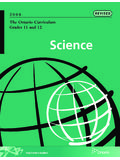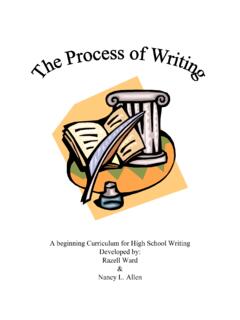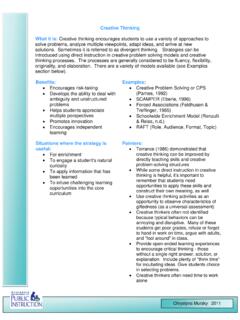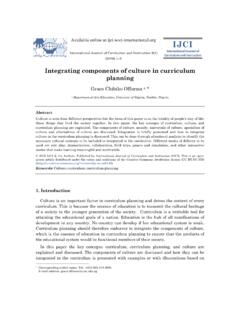Transcription of K to 12 BASIC EDUCATION CURRICULUM SENIOR HIGH …
1 K to 12 BASIC EDUCATION CURRICULUM SENIOR HIGH SCHOOL ACADEMIC TRACK K to 12 SENIOR High School Humanities and Social Sciences Strand creative Nonfiction February 2014 Page 1 of 7 Grade: 11/12 No. of Hours: 80 hours Subject Title: creative Nonfiction Pre-requisite: creative Writing (CW/MP) Subject Description: Focusing on formal elements and writing techniques, including autobiography and blogging, among others, the subject introduces the students to the reading and writing of creative Nonfiction as a literary form. The subject develops in students skills in reading, and thinking critically and creatively, that will help them to be imaginative readers and writers.
2 CONTENT CONTENT STANDARD PERFORMANCE STANDARD LEARNING COMPETENCY CODE Quarter I A. Introduction to Literary Genres 1. Understanding Conventions of Traditional Genres a. Fiction b. Poetry c. Drama d. Other forms 2. Identifying Elements of the different Genres 3. Using Elements as Techniques to develop Themes 16 hours (4 weeks) The learner understands the literary conventions that govern the different genres. ( , narrative convention of fiction, etc.) The learner clearly and coherently uses a chosen element conventionally identified with a genre for a written output 1. Identify dominant literary conventions of a particular genre HUMSS_CNF11/12-Ia-1 2. Compare and contrast how the elements are used in the different genres HUMSS_CNF11/12-Ia-2 3.
3 Analyze and interpret the theme and techniques used in a particular text HUMSS_CNF11/12-Ia-3 4. Create samples of the different literary elements based on one s experience ( metaphor to describe an emotion) HUMSS_CNF11/12-Ib-d-4 5. Write a draft of a short piece using any of the literary conventions of genre following these pointers: a. Choosing a topic b. Formulating a thesis statement c. Organizing and developing ideas d. Using any literary conventions of a genre e. Ensuring that theme and technique are effectively developed HUMSS_CNF11/12-Ib-d-5 6. Peer-edit each other s draft based on a. clarity of idea b. appropriate choice of literary element c. appropriate use of the element d. effective combination of the idea and the chosen literary element HUMSS_CNF11/12-Ib-d-6 7.
4 Revise the draft of a short piece using any of the literary conventions of a genre ( plot for narrative piece) HUMSS_CNF11/12-Ib-d-7 K to 12 BASIC EDUCATION CURRICULUM SENIOR HIGH SCHOOL ACADEMIC TRACK K to 12 SENIOR High School Humanities and Social Sciences Strand creative Nonfiction February 2014 Page 2 of 7 CONTENT CONTENT STANDARD PERFORMANCE STANDARD LEARNING COMPETENCY CODE B. Principles, Elements, Techniques, and Devices of creative Nonfiction 1. Using Elements of creative Nonfiction a. Plot b. Characters c. Characterization d. Point of View e. Angle f. Setting and Atmosphere g. Symbols and Symbolisms h. Irony i. Figures of speech j. Dialogue k. Scene l. Other elements and devices 2.
5 Developing themes by combining multiple elements 24 hours (6 weeks) The learner understands the delineation between creative and the nonfictional elements of creative nonfictional text. The learner clearly and coherently uses multiple elements conventionally identified with a genre for a written output 1. Do a close reading of creative nonfictional texts HUMSS_CNF11/12-Ie-f-8 2. Identify the fictional elements in the texts HUMSS_CNF11/12-I-e-f-9 3. Analyze and interpret factual/nonfictional aspects in the texts HUMSS_CNF11/12-Ie-f-10 4. Evaluate the relationship of creative and nonfictional elements of the texts HUMSS_CNF11/12-Ie-f-11 5. Write a draft of a short piece using multiple elements conventionally identified with the literary genres following these pointers: a.
6 Choosing a topic b. Formulating a thesis statement c. Organizing and developing ideas d. Using multiple literary conventions of a genre e. Ensuring that theme and technique are effectively developed HUMSS_CNF11/12-Ig-j-12 6. Peer-edit each other s draft based on a. clarity of ideas b. appropriate choice of literary elements c. appropriate use of the elements d. effective combination of the ideas and the chosen literary elements HUMSS_CNF11/12-Ig-j-13 7. revise the draft of a short piece using multiple elements conventionally identified with the literary genres HUMSS_CNF11/12-Ig-j-14 Quarter II A. Forms and Types of creative Non fiction a. Understanding various forms and types b. Autobiography/ Biography The learner understands the distinction between and among creative nonfiction types and forms.
7 The learner competently delivers an artistic presentation summarizing and analyzing the form, theme and techniques 1. Explain the relationship of elements and ideas found in the various forms and types of creative nonfictional texts through a close reading HUMSS_CNF11/12-IIa-15 K to 12 BASIC EDUCATION CURRICULUM SENIOR HIGH SCHOOL ACADEMIC TRACK K to 12 SENIOR High School Humanities and Social Sciences Strand creative Nonfiction February 2014 Page 3 of 7 CONTENT CONTENT STANDARD PERFORMANCE STANDARD LEARNING COMPETENCY CODE c. Literary Journalism/Reportage d. Personal narratives e. Travelogue f. Reflection essay g. True narratives h. Blogs i. Testimonio j. Other types and forms Delivering a presentation on a chosen type or form of creative nonfiction 12 hours (3 weeks) of a chosen creative nonfictional text.
8 2. Compare and contrast the different forms and types of creative nonfictional texts HUMSS_CNF11/12-IIa-16 3. Deliver an artistic presentation summarizing, analyzing, and commenting on a chosen creative nonfictional text representing a particular type or form HUMSS_CNF11/12-IIb-c-17 B. Reading and Writing creative Nonfiction 1. Reading creative nonfiction a. Analysis, interpretation and commentary 2. Writing creative Nonfiction a. Mini critique b. creative nonfiction 28 hours (7 weeks) The learner understands that mastery of the BASIC forms, types, techniques and devices of creative nonfiction enables him/her to effectively critique and write creative nonfiction. The learner writes a clear and coherent critique and an interesting and engaging creative nonfiction.
9 1. Write a mini critique of a peer s work based on coherence and organization of paragraphs, development of literary elements use of factual information, and other qualities concerning form and content HUMSS_CNF11/12-IId-e-18 2. Analyze and interpret a well-written creative nonfictional text based on the peer critique HUMSS_CNF11/12-IIf-19 3. Write a draft of creative nonfiction piece based on the learner s memorable real-life experience HUMSS_CNF11/12-IIg-j-20 4. Peer-edit and revise each other s draft based on desirable qualities of well-written creative nonfiction HUMSS_CNF11/12-IIg-j-21 5. Write the final version of one s own creative nonfiction in a composition of five paragraphs or more HUMSS_CNF11/12-IIg-j-22 Note: While assuring coverage, the sequence and time allotment may be adjusted based on the learner s pace and capacity (for Quarter I-B and Quarter II-A).
10 K to 12 BASIC EDUCATION CURRICULUM SENIOR HIGH SCHOOL ACADEMIC TRACK K to 12 SENIOR High School Humanities and Social Sciences Strand creative Nonfiction February 2014 Page 4 of 7 GLOSSARY angle involves the scope and focus in writing about real events atmosphere an element of literature that concerns the tone, emotion or mood created by a literary text based on the details of the description and narration autobiography a written account of the life of a person written by that person biography a detailed description or account of a person s life blog a web log: a website containing short articles called posts that are changed regularly. Some blogs are written by one person containing his/her own opinion, interests and experiences, while others are written by many different people.
